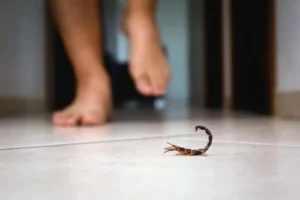Home / Blog / How to Deal With Cicada Killer Wasps
How to Deal With Cicada Killer Wasps

Scientifically reviewed by Daniel Baldwin, BCE, CCFS, CP-FS
-Published on May 17, 2023
-Updated on July 13, 2023
Cicada killer wasps appear in backyards across the U.S. during summer. These ground-dwelling wasps are large and intimidating but aren’t aggressive like yellow jackets. Still, a cicada killer wasp infestation on your property can ruin your time outdoors. Read this guide to learn more about cicada killer wasps and how to remove them from your outdoor spaces.
What are cicada killer wasps?
Cicada killer wasps are solitary wasps, also known as digger wasps. A cicada killer wasp looks like a hornet or European wasp. They can be up to 1 ½ inches long and feature a black abdomen with yellow markings and an orange tint to their wings. Males are somewhat smaller than females.

When do cicada killers come out?
Cicada killer wasps overwinter as larvae in a cocoon and burrow in the soil. Their pupation occurs in the spring, and adults begin to come out in June, with continued emergence occurring throughout the summer. They’re more active in sunlight and stay away from people, remaining in their burrows at night.
Where do cicada killers live?
Cicada killer wasps live underground and are attracted to flowers, flower beds, and loose soil. Cicada killers dig holes in the ground, creating burrows in soft, sandy, well-drained soil, often including sloped terrains, flower beds, patio edges, or soil next to sidewalks. Small piles of soil are found next to the entrances to their nests.
Cicada killer wasps can displace as much as 100 cubic inches of soil by tunneling. Females dig burrows up to 10 inches deep and extend another six inches horizontally.
What do cicada killers eat?
Adult cicada killer wasps feed on flower nectar, fermented tree sap, and other large plants near their habitat. The larvae feed on cicadas and other similar insects. Adult females use their stinger to inject venom into cicadas, paralyzing them. They then fly or drag the cicada to their nest and pull it underground for the larvae to feed.
Are cicada killer wasps dangerous?
Most cicada killers keep to themselves and are content to dig burrows and hunt cicadas. The female cicada killers can sting, but typically only if they are picked up or defending themselves.
How to get rid of cicada killer wasps
Reduce the number of cicada killers in your yard by keeping your lawn and garden beds watered. The frequent watering will push your soil back into place and often cause the cicada killer wasps to leave, as they do not like wet soil. Set up a watering schedule to keep your soil’s moisture constant. Growing a healthy, lush lawn is also a great defense against cicada killers moving in. If you see bare patches of lawn in hotter months, address them by seeding or mulching the areas immediately.
How to destroy a cicada killer nest
If you spot cicada killer nests in your soil, you can attempt to destroy them by following a few simple steps:
- Identify the horseshoe mound of dirt that typically surrounds the opening or burrow.
- Once you’ve located the burrow, use a shovel to fill the holes with soil.
- Hydrate the area heavily with water.
Pest control services
If you have concerns about cicada killer wasps on your property, contact a professional pest control service like Hawx Pest Control. Call us today for a free estimate to get your pest problems under control.
Related Articles
Visit our blog to learn more.
→






